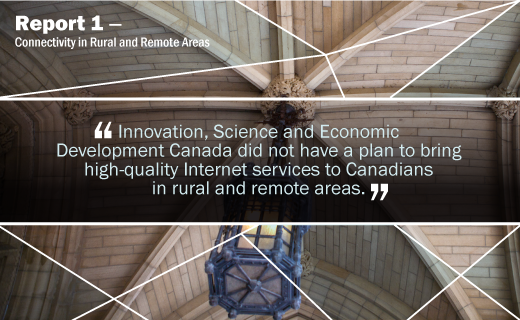Report 1—Connectivity in Rural and Remote Areas
At a Glance Report 1—Connectivity in Rural and Remote Areas
What we examined (see Focus of the audit)
Accessibility to broadband high-speed Internet continues to lag behind for certain population groups in Canada, notably communities in rural and remote areas. This is despite significant investments by the public and private sectors to support broadband deployment.
This audit focused on whether Innovation, Science and Economic Development Canada and the Canadian Radio-television and Telecommunications Commission, according to their respective roles and responsibilities, monitored the state of connectivity, and developed and implemented a strategy to meet the connectivity needs of Canadians in rural and remote areas.
Why we did this audit
This audit is important because access to reliable and high-quality Internet services enables Canadians to participate in the 21st-century economy and have better access to health care and education. This access also helps people in rural areas to connect with services that otherwise might be available only in urban areas.
Overall message
Many examinations of broadband Internet in Canada have recommended that the federal government create a national broadband strategy, but the government has not agreed to take that step. In fact, Innovation, Science and Economic Development Canada has been reluctant to establish a strategy without funding. So, the Department did not have a strategy to meet the connectivity needs of Canadians in rural and remote areas. This means that people in these areas have less access to important online services, such as education, banking, and health care, and do not have information about when they could expect better access.
In 2016, Innovation, Science and Economic Development Canada launched its Connect to Innovate funding program for broadband expansion. However, the Department did not implement the program in a way that ensured the maximum expansion for the public money spent.
Finally, small Internet service providers did not have sufficient access to high-quality spectrum to support broadband deployment in rural and remote areas. The Department auctioned spectrum licences for geographic areas that were too large for smaller service providers to submit bids for. Also, the secondary market for unused spectrum did not function well, partly because licensees had little business incentive to make unused spectrum available for subordinate licensing.
What we found about …
National broadband strategy
Connectivity funding
Radio frequency spectrum management
Entity Responses to Recommendations
The audited entities agree with our recommendations and have responded (see List of Recommendations).
Related information
| Report of the | Auditor General of Canada |
|---|---|
| Type of product | Performance audit |
| Topics | |
| Entities | |
| Completion date | 7 September 2018 |
| Tabling date | 20 November 2018 |
| Related audits |
|
For more information
Media Relations
Telephone: 1-888-761-5953
E-mail: infomedia@oag-bvg.gc.ca
Twitter: OAG_BVG
